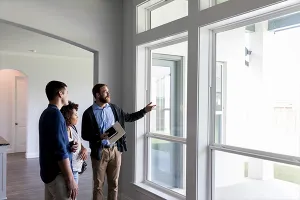Pools are a sought-after home feature, but they come with added homeownership responsibilities and potential costs. About a quarter of listed homes this past spring included a pool—a record high, according to a realtor.com® analysis of April housing data.
Jordan Schaeffer, president of Renovations and Aftermarket at Anthony & Sylvan Pools, shares what buyers should consider before purchasing a home with a pool.
What to Look for During a Walkthrough

Visual Issues
Watch for:
- Loose tiles or missing grout
- Green or discolored water
- Low water levels (could signal a leak)
- Cracks in steps, walls or the floor
Schaeffer notes that “hydration” or spider cracks are often superficial and minor hairline cracks. “The thing you want to be aware of is if there is a separation crack that… looks like you could fit a penny down there,” Schaeffer says. Surface hairline cracks may be easily fixed with just $10 in epoxy, while deeper structural or underground leaks could cost thousands.
Equipment Check
“Ask the homeowner to turn the pool on to make sure the equipment sounds right and is running,” Schaeffer advises. Watch for high-pitched sounds or signs of struggling equipment.
Coping Joint Inspection
Check the joint between the pool coping and the surrounding deck. “If that joint never gets filled in with what we call mastic compound… that would be a red flag,” says Schaeffer. Water can get behind the coping and damage the pool structure, especially in areas with freeze-thaw cycles.
Ask for Photos If the Pool Is Closed Up
If you’re buying in the off-season or the pool is covered, Schaeffer recommends asking the home seller for recent photos. “Ask to see last summer’s pictures of the pool… [and have the seller] affirm that the equipment’s been running well and there are no issues.”
Consider an Inspection
A standard home inspection doesn’t typically include a pool inspection, though some inspectors may offer it as an add-on. Usually, home buyers will need to have a separate specialized pool inspection—averaging between $125 and $250. A qualified pool inspector can assess the condition of the pool and identify potential issues, such as with the pool’s shelling, coping and deck that could indicate cracks and leaks. To find a pool inspector, you can check out professional associations such as the Pool & Hot Tub Alliance.
Budget for Ongoing Maintenance
Pool maintenance costs typically range from $1,000 to $4,000 per year, according to Family Pool Maintenance. Many owners use a mix of professional help and DIY for pool upkeep.
Tips:
- Leave electrical repairs to the pros: “Anytime you're mixing water and electricity… let the professional do that,” Schaeffer says.
- Never drain the pool yourself: It may seem simple enough to do on your own, but improper drainage can cause the pool to lift out of the ground due to hydrostatic pressure, he cautions.
- Year-round care is a must: “It’s an open body of water outside... and you have to stay on top of the maintenance,” Schaeffer emphasizes. “If you’re ahead of the maintenance game, you’ll spend less in chemical costs and repairs over the long run. If you ignore it… you're going to spend a bunch of money in remediation chemicals.”
Does a Pool Add Resale Value?
A 2025 realtor.com® study found that homes with pools sold for a 54% premium—$599,000 versus $389,000 for homes without. Pools remain a strong selling point, even after the fading so-called “pandemic premium” for pools.
“During the pandemic, people were looking for ways to get more enjoyment out of their homes, and this surge in demand for features like pools, translated into a substantial ‘pool premium,’ where homes featuring a pool commanded significantly higher asking prices compared to their pool-less counterparts,” says Hannah Jones, senior economic research analyst at realtor.com®. The pandemic pool premium peaked in January 2022, and “although price premiums have normalized, the presence of a pool continues to drive a premium and be a popular item to include in listings as a home or community feature,” Jones says.
5 Popular Pool Upgrades

Schaeffer says that updating an older pool could enhance the home’s resale value and personal enjoyment. Popular upgrades include:
- Automation: “With older pools everything is manual, but newer pools you can control –[maintenance] with an app,” Schaeffer says. This includes scheduling cleaning, filtration and even chlorine levels.
- Energy efficiency: “Switching to a variable speed pump… that’s huge for resale value,” he says. This type of pool pump allows owners to adjust the motor’s speed, allowing for greater energy efficiency and cost savings over single-speed pumps.
- Water features: Waterfalls, bubblers or jump rocks have become popular add-ons.
- Sun shelf additions: Also known as tanning ledges, these are shallow areas of a pool and have become trendy upgrades for older pools, Schaeffer says.
- Darker pool finishes: Pools traditionally have been white and blue, but shades like “raven” or “smoke” are growing in popularity with Anthony & Sylvan Pools. “The water looks almost black,” he says. “That’s starting to become very common.”









